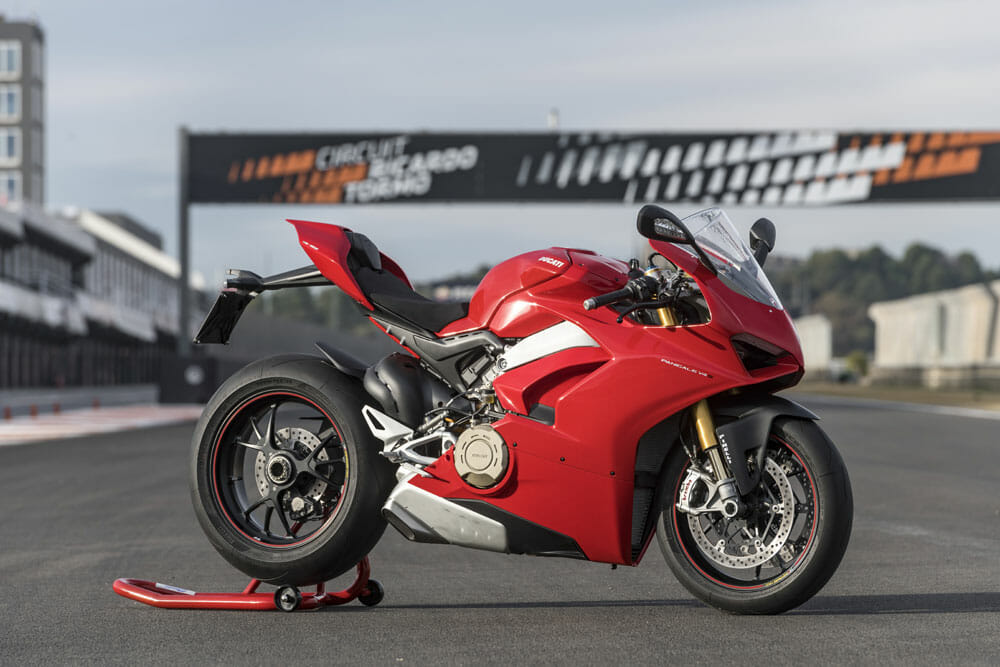Rennie Scaysbrook | February 1, 2018
A Brave New World
The Ducati Panigale V4S is finally here. A technical tour de force, we flew to the MotoGP circuit in Valencia, Spain, to see if it really is the sum of its parts.
 The new era has arrived. The Ducati Panigale V4S really is that good.
The new era has arrived. The Ducati Panigale V4S really is that good.
2018 Ducati Panigale V4S | FULL TEST | It’s an unwritten part of this job as a motorcycle writer not to get too overexcited when something new and shiny comes along. It’s best to remain somewhat reserved, judge whatever bike you’re talking about with a strict hand and move onto the next one promptly.
The problem with this is approach is it doesn’t consider the feelings that fall onto your soul when you ride a motorcycle like the Ducati Panigale V4S, because there are bikes, and then there’s this—a new benchmark in sports motorcycles—one that’s red and oh-so-Italian, so hopefully you’ll forgive me for letting the emotions show, somewhat.
The Ducati Panigale V4S is easily the most anticipated sports machine of 2018 and for good reason. It marks the end of Ducati’s V-twin superbike era and its first step into the brave new world of four-cylinder superbike motors.
And before I go on, I’ll address the elephant in the room in that, yes, this is not a true superbike motor by racing definition at 1103cc. It’s 103cc more than every other four-cylinder superbike motor, save for the ultra-exclusive, 1200cc, Norton V4 RR, and is therefore ineligible for every form of competition except for a “run what ya brung” class.
For racing, a 999cc R-version will come later in the year and will be the bike you’ll see in WorldSBK from 2019 onwards.
So therefore, it doesn’t matter this particular V4 is oversize—because if riding a motorcycle is about making you laugh like an escaped asylum patient, the Ducati Panigale V4S is your Jaws of Life.
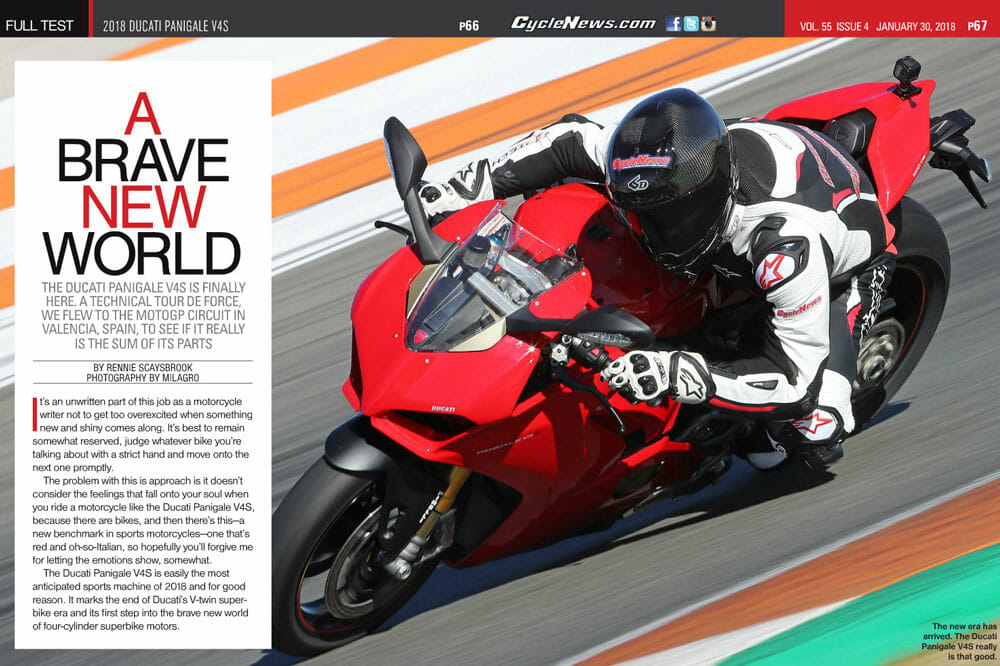
PHOTOGRAPHY BY MILAGRO
Expect More, Get More
The numbers thrown up by the new V4 make for eye-watering reading. A claimed power output of 214 horsepower (at the crank) pushing a claimed curb weight of 430 pounds for the S version we tested at Valencia, ensure this will be the fastest production machine ever created by Ducati—including the legendary Desmosedici D16RR of 2006.
Compared to the outgoing twin-cylinder 1299 Panigale S, you’re getting 17 horsepower more with the V4 for the tradeoff of a 9.9-pound vehicle weight gain, one that is hidden so beautifully in the new chassis it’s impossible to tell.
The Panigale V4S enjoys many things new, namely the company’s Front Frame design that weighs just 9.2 pounds. This is mated to a magnesium headlamp and mirror support, a cast-aluminum subframe and swingarm, and forged aluminum Marchesini wheels. And there’s a ton of incredible electronics with the Ducati Traction, Ducati Wheelie Control, Engine Brake Control and Ducati Slide Control getting new algorithms as well as new colleagues in the Ducati Slide-By-Brake system and new Öhlins Smart SE 2.0 electronic suspension that’s a vast improvement over what was on the previous V-twin version. Plus, it’s all accessed via the best dash Ducati has ever fitted to a production motorcycle, one that’s easy to read and easy to use which is critical, considering the number of parameters you can change on this incredible machine.
 The beast: But like a nightclub bodyguard, the V4S can be as brutal or as enjoyable as you like.
The beast: But like a nightclub bodyguard, the V4S can be as brutal or as enjoyable as you like.
The Dominator
Yet for all its electronic and chassis trickery, there’s only one lead tenor in this new Ducati opera, and that’s the new 1103cc Desmosedici Stradale V4 engine. And while it may seem like an odd venue to launch such a powerful machine given its near stadium-like dimensions, the Valencia MotoGP circuit highlighted just how flexible yet downright demonic this new V4 is.
The first thing you’ll notice before you even take off from a stop is the V4 doesn’t sound like a four-cylinder motor. Running a twin-pulse firing order and using a 70° crank pin offset to mimic a V-twin’s behavior, the V4 fires its cylinders at 0°-90°-290°-380° and enjoys this gruff, deep engine note which sounds more like the old twin than a four, although that’s about where the similarity between the two end.
On track the V4 is not as torquey as the old twin, obviously, but it’s so, so much smoother in its delivery. The V4 has an insatiable appetite for revs, pulling reasonably hard from 4000 rpm, but rocketing from 6500 rpm to a redline of 14,500 rpm so fast it’ll make your head spin.
It has power to absolutely burn around the tight confines of Valencia and will feel right at home at somewhere like the open spaces of Road America, where you’ll really be able to let it off the leash. Who the hell cares if this motor isn’t race legal? If you do care, then you don’t like fun, and we can’t be friends.
 We got five laps on this V4S fitted with slicks and the Akrapovic titanium race exhaust that is part of the Ducati accessory range. With a claimed 226 hp offered by the pipe, it made for the most powerful production machine Rennie has ever tested.
We got five laps on this V4S fitted with slicks and the Akrapovic titanium race exhaust that is part of the Ducati accessory range. With a claimed 226 hp offered by the pipe, it made for the most powerful production machine Rennie has ever tested.
One of the aces in the motor’s hand is the new counter-rotating crankshaft. Commonplace in MotoGP, Ducati fitted the V4 with this crank to produce inertia-linked torque in the opposite direction to wheel travel, helping the back-end stay planted under heavy braking and the front to stay closer to the ground under hard acceleration (don’t worry, it still does wheelies. Big ones).
It works tremendously well, especially under hard acceleration. You can pin the throttle to the stop onto the Valencia front straight and when combined with the traction and wheelie control systems, the front will stay close to the ground and the speed will increase scarily fast as you click up that oh-so-sweet Ducati Quick Shift (DQS) gear change.
The counter-rotating crank adds some extra weight than what a traditionally spinning crank would because it needs an extra gear to change the rotation direction, but it’s absolutely worth it because this V4 is more powerful, smoother and just downright better than any production engine Ducati has ever made.
The engine experience is tightly controlled by the electronics, with the variable riding modes of Street, Sport and Race offering vastly throttle responses, which is to be expected. It opens the machine up in ways unimaginable to the V-twin, which even Ducati CEO Claudio Domenicali told me could be like the bike riding the rider, instead of the other way around. The initial throttle response in every mode—but especially the Race mode—is direct and predictable. It makes opening the gas wide open a total joy, as the revs reach for the sky and you tuck as best you can behind the rather low angled screen.
 New Öhlins front and rear are a huge improvement over the first generation of suspension fitted to the Panigale range.
New Öhlins front and rear are a huge improvement over the first generation of suspension fitted to the Panigale range.
Controlling the Punch
The electronics permeate every being of this bike, but none more so than in the acceleration phase. Pinning the throttle will have you engage the traction, wheelie and slide control, as well as activating the electronic steering damper and Öhlins Smart EC 2.0 suspension (which, to be fair, is always working, unless you switch to manual mode).
While not remarkable in that other machines have similar systems, it’s amazing how well these systems are managed by the Bosch Inertial Measurement Unit and the feeling of precision and control at the twist grip and eventually, the rear tire.
The machine is constantly working beneath you, changing and altering itself to ensure you’re always in the optimal chassis setting to get yourself around the track as fast as you can make it go.
The traction and wheelie control systems are especially impressive. Even when I was deliberately riding like a bit of a dick and trying to fool the system by slamming the throttle wide open down the front straight, there’d be nary a cough or splutter from the motor as the ignition was gently cut, the power dumbed down slightly but drive still forceful enough to make it feel like I was not being slowed down in the slightest. That, and the front wheel was hovering just a few inches off the deck to make me feel like a proper MotoGP badass when the truth is so, so far from that.
 In the nude: There’s more chassis than what’s on the monocoque design with the new Front Frame, but the moto is still an integral part of the chassis design.
In the nude: There’s more chassis than what’s on the monocoque design with the new Front Frame, but the moto is still an integral part of the chassis design.
It’s a similar story under brakes, as the counter-rotating crank works in conjunction with the new algorithms in the DQS, the Öhlins Smart EC 2.0 and Engine Brake Control (EBC) systems. The EBC is variable by three levels with one being the least electronic intervention and three the most (think of it as level one is a four-stroke and level three is a two-stroke in terms of engine braking), so you can dial in the exact amount of engine braking you like.
But if you want your braking to be totally spectacular, you can attempt to engage the Slide-By-Brake system that’s only available in Sport, not Race, mode. The Slide-By-Brake system is part of the Bosch ABS Evo system and allows you to get on the rear brake hard and it’ll help you pivot the back-end out, and start sliding to the apex. Personally, I didn’t care for this system too much because I am not a heavy rear-brake user and, if I were actually good enough to benefit from such a move, I would pivot the bike into the apex without the electronics—like Kyle Wyman does so well. For my money, this feature is a bit pointless, but it’s not like it adds weight to the bike (being just an algorithm and all), so if you don’t like it, don’t use it.
 Is that not one of the sexiest back-ends you’ve ever seen?
Is that not one of the sexiest back-ends you’ve ever seen?
Hustling the beast
Who remembers watching Chaz Davies pitching the Panigale into almost every corner on the WorldSBK calendar with the chassis totally bend out of shape? No doubt that has a lot to do with just how Chaz likes to go fast, but I can’t imagine he will have quite the same problem when/if he rides a V4 in 2019.
That’s because the V4 is such a nicer bike under brakes and into the first part of the corner, giving the rider far greater confidence to turn in late and hard without requiring quite the skill Mr. Davies has.
Again, this characteristic of the bike is a product of all things electronic (Öhlins, DTC, EBC, DQS, electronic steering damper and Slide-By-Brake if you’re using it) combining with a mechanically brilliant engine and the new Front Frame chassis platform to aid the rider rather than hinder him in making fast lap times. But it doesn’t disguise the fact the new Brembo Stylema calipers are another step forward in braking prowess that started with the release of the M50 calipers a few years back.
 The muffler is surprisingly quiet in standard trim, but if you fit the full Akrapovic titanium exhaust, you better cover your ears!
The muffler is surprisingly quiet in standard trim, but if you fit the full Akrapovic titanium exhaust, you better cover your ears!
The Stylema/master-cylinder combination give incredible braking and feel and will highlight just how bike unfit you really are after 10 good, hard laps. This thing stops very, very quickly, pretty much as fast as it accelerates, so you can get on with the job of setting yourself up for the corner that is fast approaching.
That corner is now dealt with in a much smoother fashion than before, as everything going on beneath you syncs up and you scythe through the bend. Stability is king here, with the Öhlins Smart EC 2.0 ECU optimizing the NIX30 fork and TTX36 shock every step of the way. It’s an incredibly smart system, allowing you to optimize the braking, mid-corner and acceleration phases independently. You can go further by switching to full manual mode, which takes away the continuous electronic adjustment and lets you go old school by setting your bike up in the pits the way you like.
 Slightly reworked compared to the 1299, the Panigale V4S’s snout is still somewhat mean.
Slightly reworked compared to the 1299, the Panigale V4S’s snout is still somewhat mean.
You will not, however, be doing the adjustment with a screwdriver and a C-wrench, as it’s all done via the five inch TFT dash that is without a doubt the best dash Ducati has ever used. The instrumentation is extremely easy to read and navigate via the left-hand switch block, and a far, far cry from Ducatis of old. Click HERE for more on the dash.
 The dash is a truly exceptional piece of engineering and is a joy to use.
The dash is a truly exceptional piece of engineering and is a joy to use.
The Ducati Panigale V4S is one of those motorcycles that will force other manufacturers to rethink their approach to what a superbike can and should be. The argument for race specials and big bore streetbikes will surely rage harder than ever now, because the V4S’s extra capacity, along with its exceptional running gear and class leading electronics, are now sitting at the head of the sportbike table. The big thing to take away from my four 15-minute sessions on the Ducati Panigale V4S is that now the Panigale brand has gone from being a nemesis of fast lap times to an ally you can rely on—it’s become easier to ride, and is now a bike that works with you, rather than against you.
Ducati has really, truly, created a landmark motorcycle with the new Panigale V4S.CN
 Ducati has absolutely hit this one out of the park—regardless of racing rules—this bike is one you’ll never want to stop riding.
Ducati has absolutely hit this one out of the park—regardless of racing rules—this bike is one you’ll never want to stop riding.
Come along to the world press introduction of the 2018 Ducati Panigale V4S at the Valencia MotoGP racetrack in Spain:
The beating heart
Ducati’s new 1103cc V4—dubbed the Desmosedici Stradale—is almost like two V-twins bolted together, and if you looked at the motor side-on you could almost forgive yourself for thinking it’s the old twin-cylinder engine. That’s because the motor is still a 90° layout, as Ducati superbike motors have always been. The fact they have a V4 in their ranks means Ducati doesn’t have to use a counterbalancer, which would increase weight and sap horsepower.
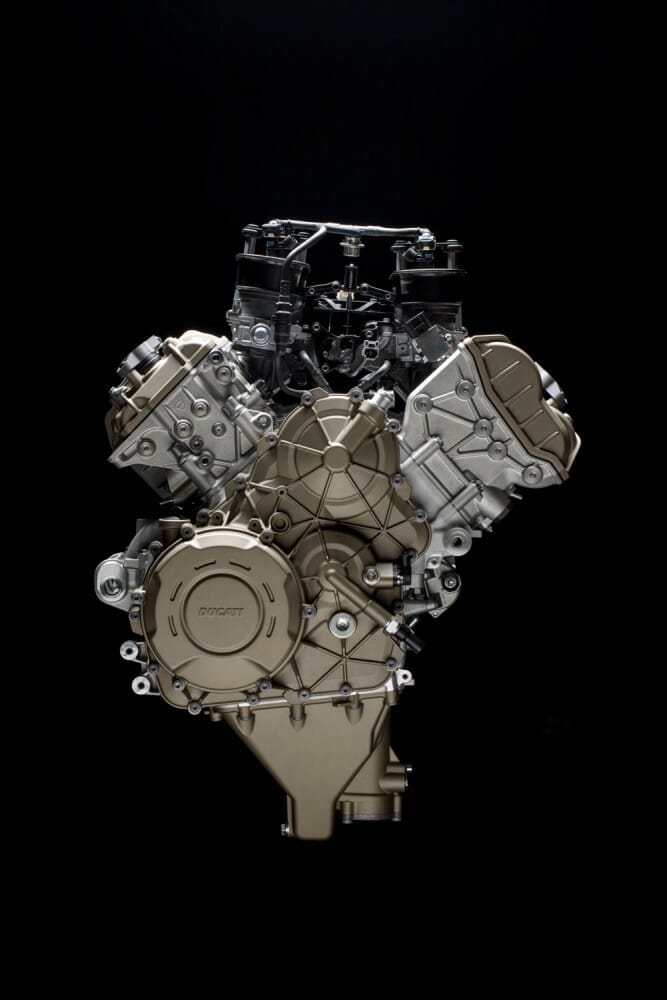
A structural member of the chassis, the V4 has several benefits over a traditional inline four, namely it allows for a much more compact design, better mass centralization and it reduces the bike’s frontal section. Indeed, this new motor is 28mm shorter, 38mm shorter front to back, but 43mm wider side-to-side than the old twin. Not bad considering there’s twice the number of cylinders, conrods and the fact the crank needs an extra gear to reverse its rotation.
The motor sits slightly cantered rearwards at 42°, the same as Dovi’s bike in MotoGP, which allows for optimized weight distribution, let’s the engineers fit bigger radiators and means the swingarm pivot can be moved as far forward as possible. The engine weighs 143 pounds, 4.8 pounds more than the outgoing 1285cc Superquadro L-twin, and has a 15,000 mile service interval for valve adjustments.
First of its kind
The V4’s intake system houses the first variable height intake funnels on a production Ducati, which send air into the quartet of 52mm throttle bodies. But unlike other manufacturers which will have either a short stack for high rpm and a long stack for more torque, the Ducati system constantly varies depending on what the rider is asking for.
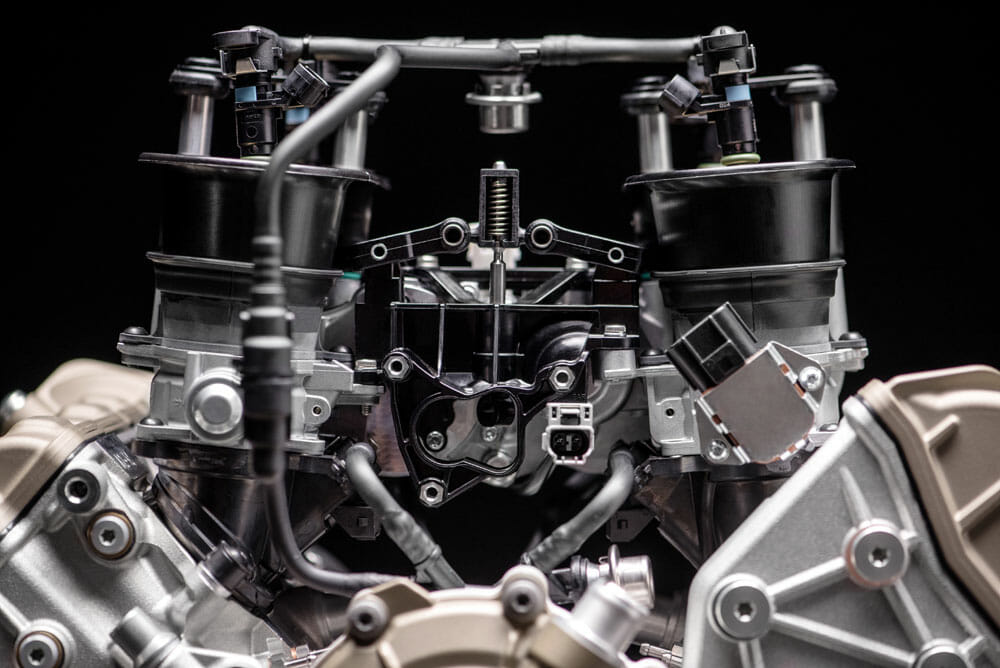
As for fueling, each throttle body has two injectors, one used when cruising and one for when you’re really trying to get maximum power out of the motor. Naturally, the throttle is a ride-by-wire system, with three modes in Road, Sport, and Race.
It wouldn’t be a Ducati without…
Operating the valve train is a revised Desmodromic system, as on every Ducati, where the valves are mechanically closed instead of relying on a spring. Where this one is different is it has come in for some serious weight savings with redesigned, miniature component used compared to the outgoing L-twin. There’s 16 valves measuring 34mm on the intake and 27.5mm on the exhaust and four camshafts controlled by two cam chains.

Just Like MotoGP
Ducati has been more than proud to chant the Desmosedici Stradale’s pistons slide up and down an 81mm bore—the same as Andrea Dovizioso and Co.’s MotoGP monsters. The pistons themselves contain box-in-box technology, which essentially helps reduce the inertial loads on the piston while helping it retain the required strength, stiffness and most importantly, light weight. The Panigale V4 also uses a sky-high compression ratio of 14:1, with the pistons working on forged steel conrods that have an eye-to-eye measurement of 101.8mm.
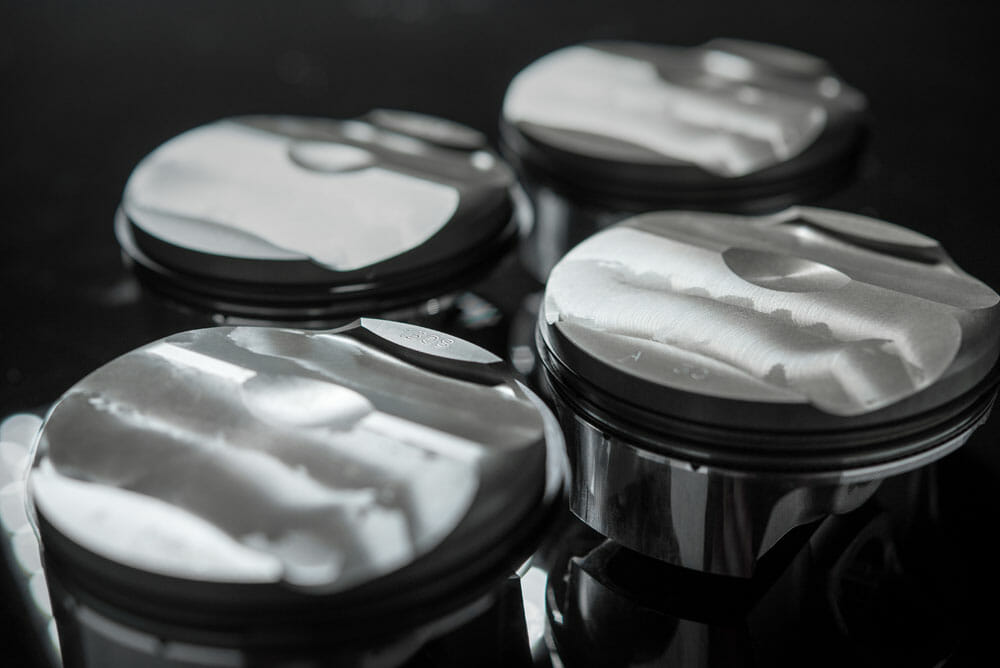
Same, but different
The Desmosedici Stradale’s crank is the first counter-rotating unit to be fitted to a production Ducati. Every team in MotoGP uses a counter-rotating crank, which first helps offset the gyroscopic effect of the turning wheels, which enables better handling and agility. Secondly, the counter-rotating crank produces inertia-linked torque, so when the bike wants to naturally wheelie under acceleration, the crank will help keep the front wheel lower to the ground so you can keep the throttle pinned. The same is true for braking, as when you slam hard on the brakes the back wheel will come off the ground, a phenomenon the crank direction also helps mitigate.
To do so, the crankshaft requires a reversing jackshaft to transfer drive through the gearbox to the rear wheel, to make sure it turns the correct way. We don’t want a 200 mph reverse bike now, do we?
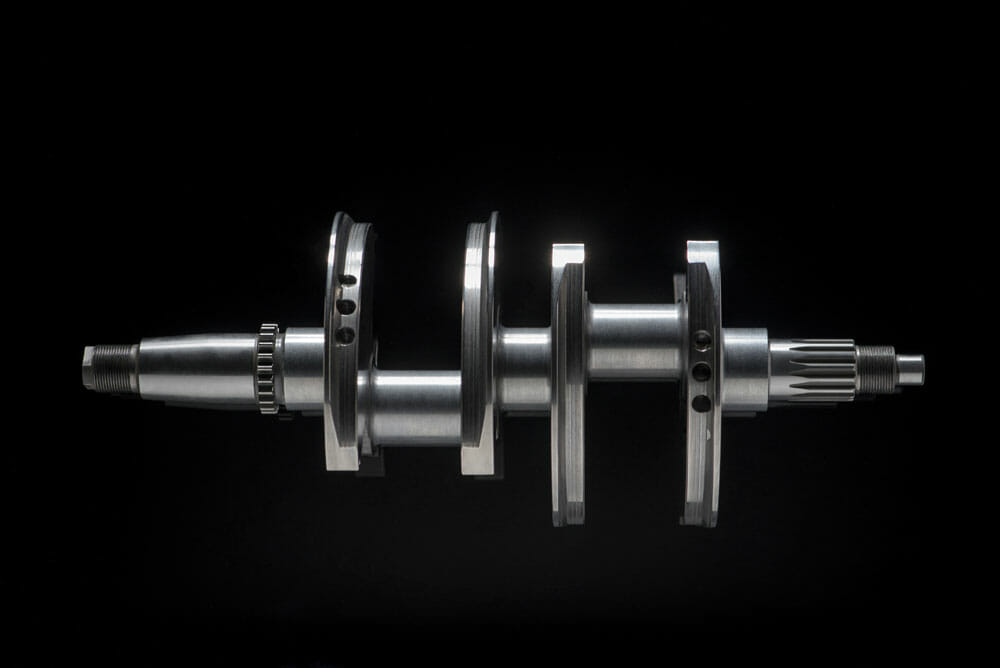
The Twin Pulse Effect
The crank pin offset is 70°, which gives the V4 an almost V-twin-like character. This enables a firing order of 0°, 90°, 290° and 380° and is called Twin Pulse, because it’s almost like the motor is a massive V-twin, rather than a four. If you think about a full cycle, the first cylinder to fire is the front left at 0°, then the rear left at 90°, followed by the front right at 290°, and finally the right rear cylinder fires at 380°. The result is not only a totally unique sound, but a smoother torque delivery than a traditional ‘big bang’ or ‘screamer’ format. The Ducati employs a semi dry sump, just like on the MotoGP bikes.
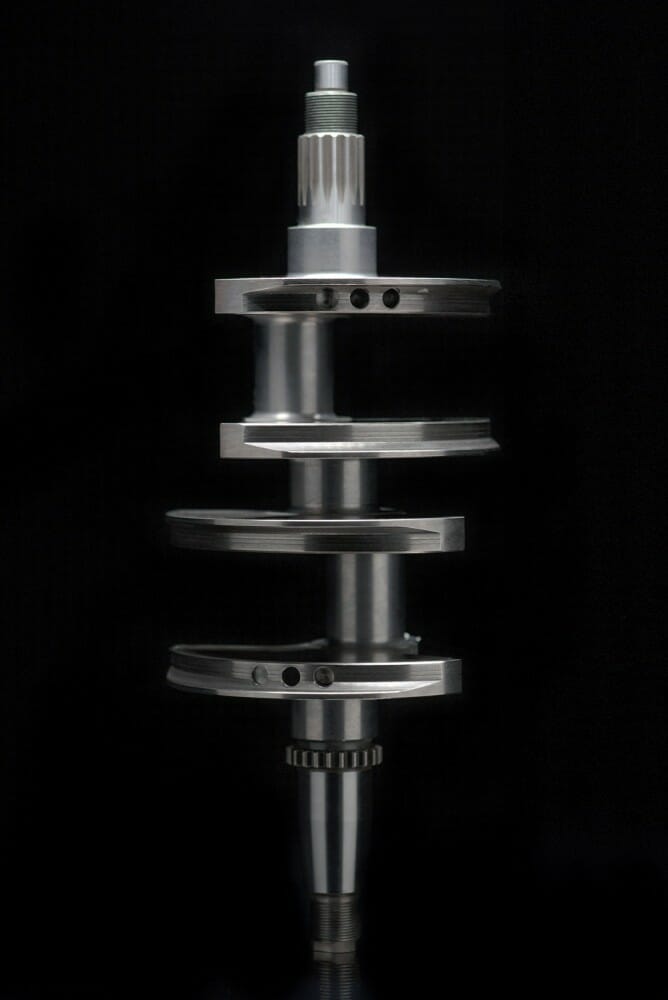
Hold it flat
The V4 comes standard with the up and down-shift Ducati Quick Shift system, which means you’ll not touch the clutch once you’ve left the lights until you want to come to a stop. The gearbox itself is a six-speeder and the clutch wet with 11 driving plates, and it also has a self-servo mechanism (like a Slip & Assist unit) that compresses the friction plates when under drive without any extra effort from the rider. This has the added benefit of making the lever nice and light, while allowing for super aggressive downshifts without locking up the rear wheel, but the system will not engage and allow clutchless downshifts if you’re above 13,000 rpm.
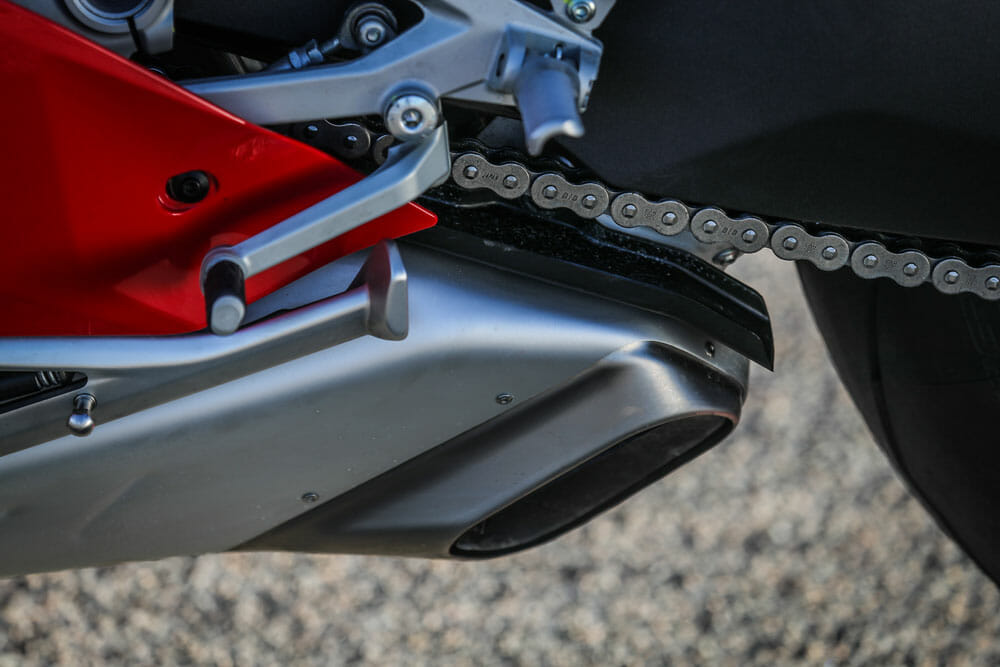
That Front Frame
The chassis is the first Ducati Front Frame, an evolution of the monocoque that was first debuted in MotoGP and later in the first generation Panigale. Think of the Front Frame as half a twin-spar design—the engine is still a structural chassis member—but the thick, beefy Front Frame allows the engineers to vary torsional and lateral rigidity separately to make the bike handle the road surfaces with better stability. All up, the Front Frame weighs 8.8 lb, and is secured to the upper half crankcase of the front cylinder head and to the rear cylinder head. The motor itself also acts as the anchoring point for the rear suspension and a pivot point for the single-sided swingarm.

The front subframe is made from magnesium, with the seat subframe constructed in aluminum and secured to the bike via the rear of the Front Frame and to the rear cylinder head.
Golden Legs
If it’s a special Ducati, it’s gotta have Öhlins. The V4S and the Speciale are both graced with the new Öhlins Smart EC 2.0 system that operates and controls the action of the NIX30 fork and TTX36 rear shock. The new system works off what Öhlins call their new Objective Based Tuning Interface, which is basically a funny way of saying the system understands how you ride and compensates for it. For example, if you’re riding hard, it knows to put everything on the stiff side for damping rates by taking into account factors like lean angle, throttle position, gear position and chassis pitch.
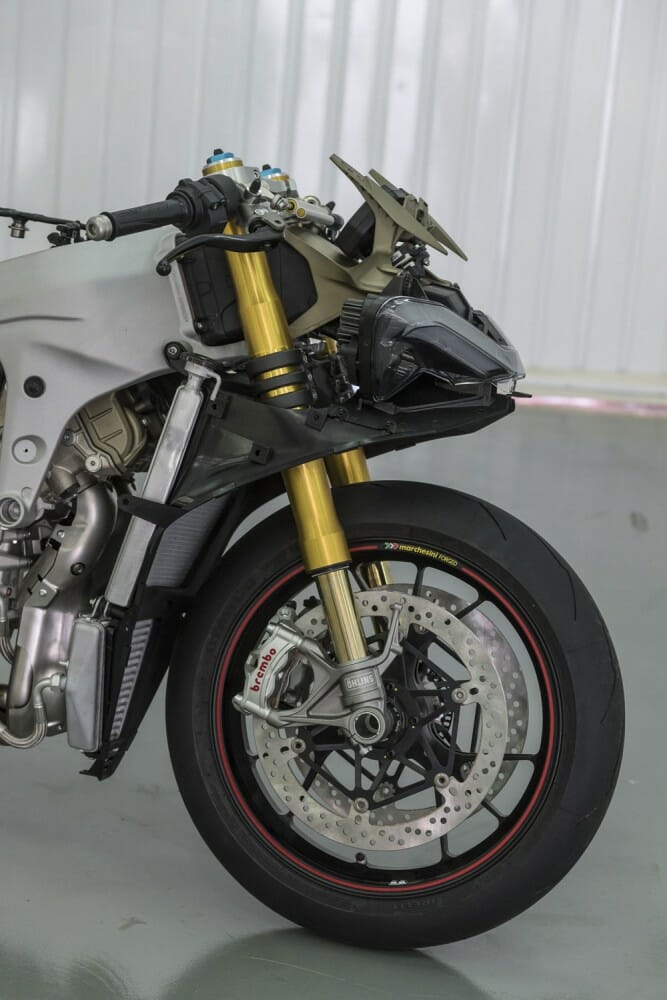
Being an electrical system, you won’t be changing your settings with clickers and screwdrivers. Öhlins believes the best way to get optimal suspension performance is to change how we look at adjusting it. So instead of compression, rebound and preload, we now change the system according to what we feel is the problem. If you want better braking balance, go into the braking area of the system and adjust accordingly. The same for midcorner performance and acceleration. This is not an entirely new way of looking at suspension adjustment as this is the second generation of Öhlins’ electronic suspension, but it does make sense and will likely make it less intimidating for people to really explore what their suspension can do. Hey, if you screw up your settings, you can just press a button and the system will return to factory settings. Should you want to switch entirely to manual mode, you can vary compression and rebound as you would on a traditional suspension setup.
New Pirellis
Pirelli has developed a special Diablo Supercorsa SP SC2 rear tire that’s slightly taller in profile. Now measuring 200/60 ZR17 instead of the 1299’s 200/55 ZR17. The new tire size is a popular slick option in WorldSBK, and allows for more contact patch on the ground at full lean. The SC2 tire itself is a dual-compound construction, with the shoulder compound the same as in WorldSBK, while the center is a harder construction.
The front tire is also slightly wider to aid midcorner grip.
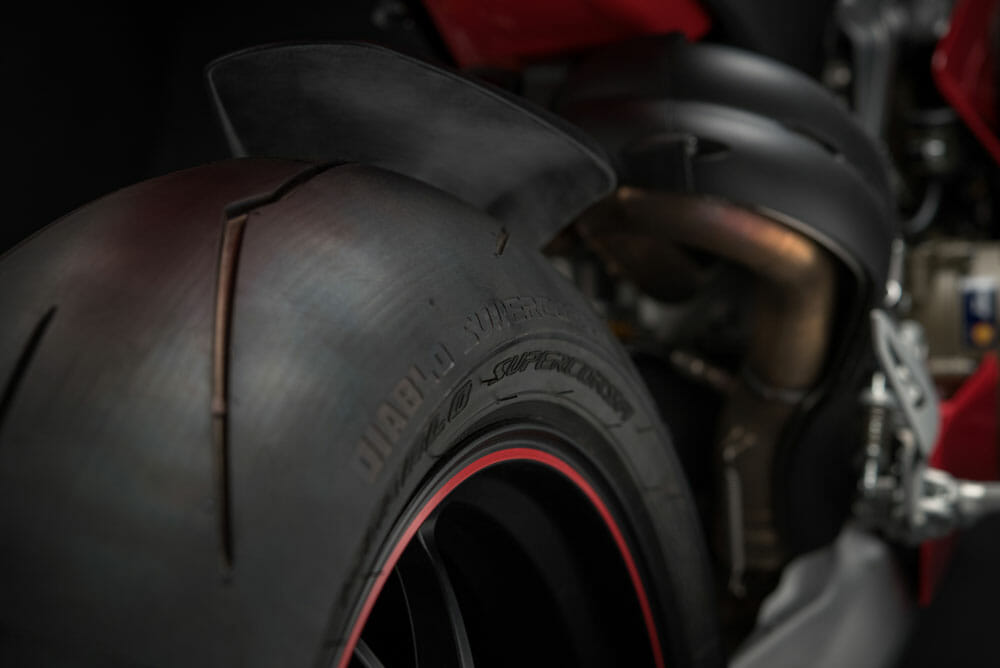
Style masters
The Panigale V4 range is now graced with the latest generation of the four-piston Brembo monobloc M50 caliper, now dubbed the Stylema. The Stylema’s are machined from a solid piece of alloy and weigh approximately 1/4-pound less than the outgoing M50s. Each piston measures 30mm, gripping a twin 330mm discs. At the rear, a twin-piston caliper stops a 245mm disc with the entire system modulated by the new ABS Cornering EVO system, which uses the extra-lightweight 9.1MP Bosch control unit.
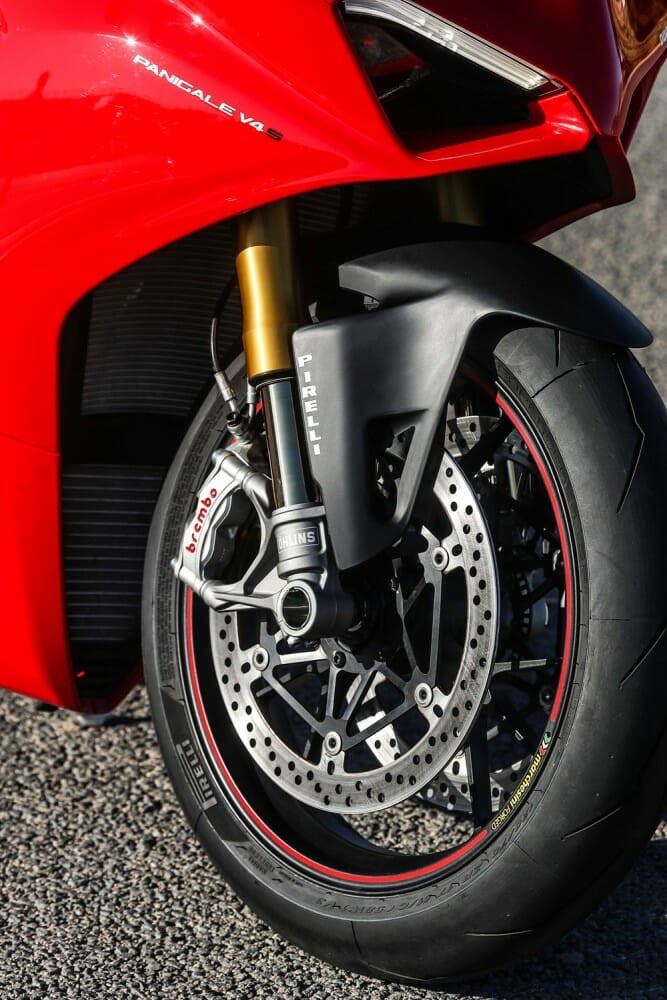
Race-style gas tank
Common practice in racing machines is to mount the gas tank with part of it under the rider’s seat. That way, the bike’s behavior becomes more predictable when the fuel load decreases. The Panigale V4’s tank is mounted this way for another reason—that being the electronics/brains of the bike, are mounted at the front of where the tank would normally be, behind the steering head.
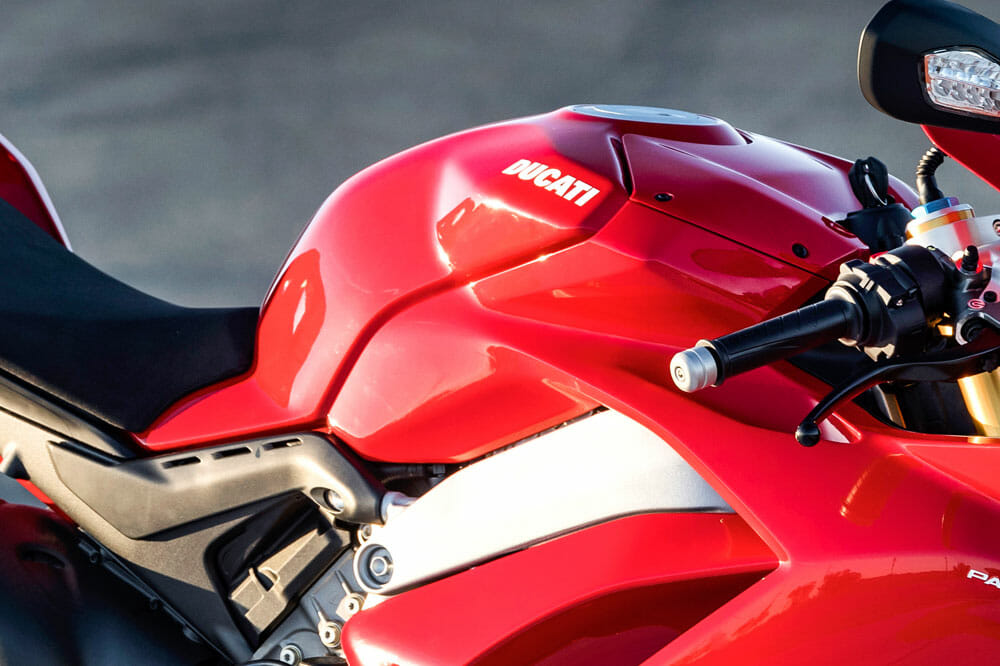
It’s all in the traps
The Ducati Panigale V4S has a number of style points that differ it from the 1299, but none more so than the “shoulders”, which is the area at the front of the gas tank where the top of the fairing meets it. This area was specifically designed to accentuate the profile of the headlight and expose the front frame as much as possible. It also means the rear cylinder head is exposed.
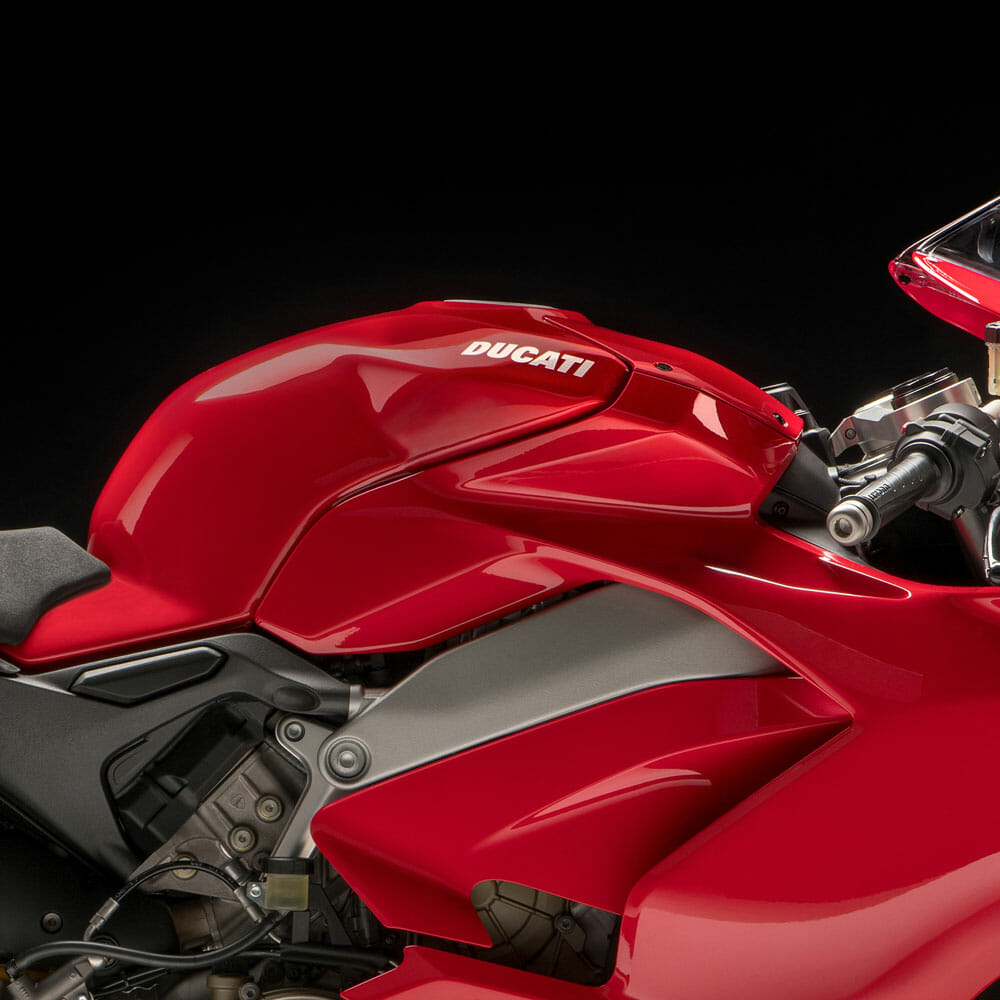
The lights are interesting in that designer Julien Clement wanted to hide the two high- and low-beam projectors as much as possible. The result is a front that looks very much like a racebike but with still an exceptional amount of visibility for nighttime riding.

We did a quick chat with Clement which you can read by clicking RIGHT HERE.
That glorious dash
The dashboard is one of our favorite little pieces on the new Ducati Panigale V4S. It’s so well designed and intuitive it makes you wonder why Ducati dashes where such a pain in the ass for so long.
The dash is a five-inch TFT display and allows you to change from track to street settings easily via the left switchblock. On the fly changes are now much easier, as in the right corner you will get everything from the DTC to the EBC settings, which you simply select what you want to change, close the throttle, confirm the setting, and ride away. Easy.
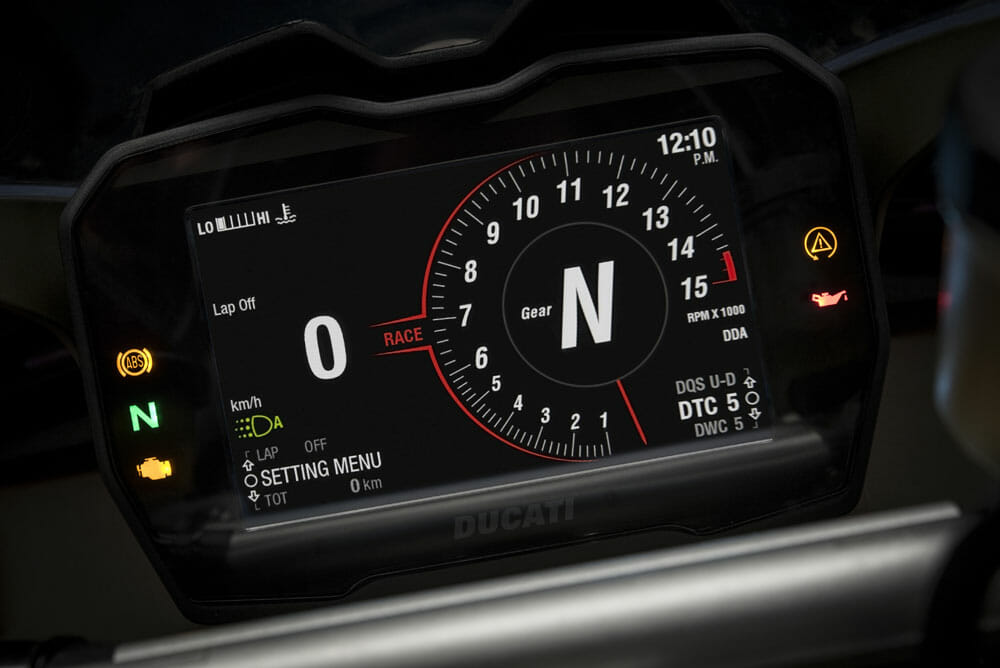
Track display allows for a focus on laps times in the top left corner, gear position, speed, as well as a digital rev counter designed to look like an analog tacho. Road setting shows the Ducati Multimedia System information and rpm, speed, gear, and trip information like trip time, fuel, average speed, air temp and all the various levels of the electronic modes like DWC, DTC, etc.
Within the dash you’ll get access to the Ducati Data Analyzer + GPS (DDA + GPS) system and the Ducati Lap Timer (DLT GPS), which an incredible took for allowing you to gauge just how quickly you’re going around the track, where you can improve via the GPS locator and how much faster you are than your buddy!
Electronics for days
The Ducati Panigale V4S’s electronics work based off information from the six axis Bosch Inertial Measurement Unit that instantly detects the motorcycle’s roll, yaw and pitch angles. The information that comes to the ECU and is then sent to the various systems means the bike is constantly moving, changing and adapting to what’s happening underneath it, making this the most electronically technical machine Ducati has ever produced.
This is just a brief overview of each system:
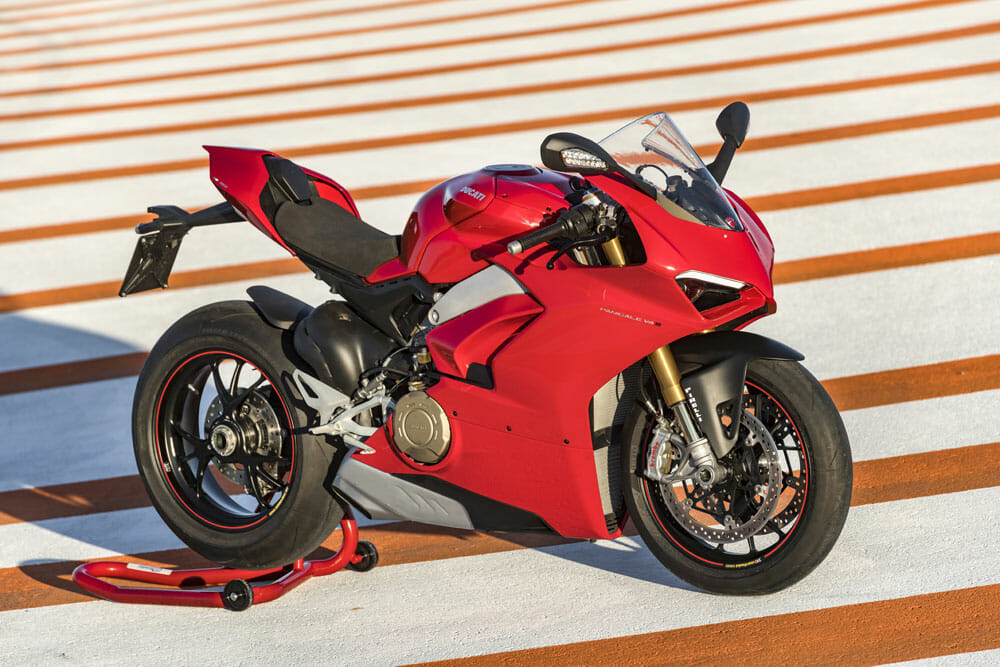
ABS Cornering Bosch EVO
The ABS has come in for an upgrade, as it now has a Cornering feature that allows for greater levels of control right up to the apex of the corner. There’s three levels, with level three designed for low-grip situations on the street, and a high degree of electronic intervention. Level two houses the Slide-By-Brake feature, which allows a rider to slide the rear of the bike into the corner by hammering the rear brake and the electronics helping to pivot the chassis into the apex.
Level one is for track riding only, and disengages the ABS action on the rear brake while still maintaining some electronic intervention on the front.
Ducati Traction Control EVO (DTC EVO)
Using information from the IMU, the DTC EVO has eight different levels, plus off. Level eight gives the most electronics intervention and one the least. The system works by detecting wheelspin and then closing the throttle bodies and reducing spark and ignition advance. The system also houses a new function called Spin On Demand in levels one and two, where a skilled rider can request more wheelspin than would otherwise be permitted, which allows the chassis to pivot around the front wheel to tighten up the corner.
Ducati Slide Control (DSC)
This feature was first introduced on the Superlegerra of 2017, and is again another product of the IMU. Contrary to what many think, this is basically an anti-highside device, in that it allows a certain degree of slip before the system reins you in and you go highsiding yourself into next week. There’s two different setting available here, which work together with the DTC and the Ducati Wheelie Control systems to ensure maximum drive always.
Ducati Wheelie Control (DWC)
The Ducati Wheelie Control algorithm works by detecting front-wheel lift under hard acceleration, allowing you to keep the gas pinned for the best corner-exit drive. There’s eight available settings for the system, although most riders at the test dialed it back to levels one or two.
Engine Brake Control EVO (EBC EVO)
Engine Brake Control varies how much engine braking you’ll get when you shut off the gas going into a corner. Level three is the most electronic intervention and one the least, although you can switch the system off completely. A lower level of intervention means more mechanical engine brake, which in theory should allow you to tighten your line midcorner.
Ducati Electronic Suspension EVO (DES EVO)
See Golden Legs for more on the Öhlins.
The Öhlins Smart EC 2.0 electronic suspension system has two modes—Fixed and Dynamic—and in Fixed mode allows for the compression and rebound to be set manually via 32 virtual clicks for the fork from fully open to fully closed and 10 for the shock, in the ECU.
Dynamic mode means the system does everything for you, changing and altering the suspension settings as you ride.
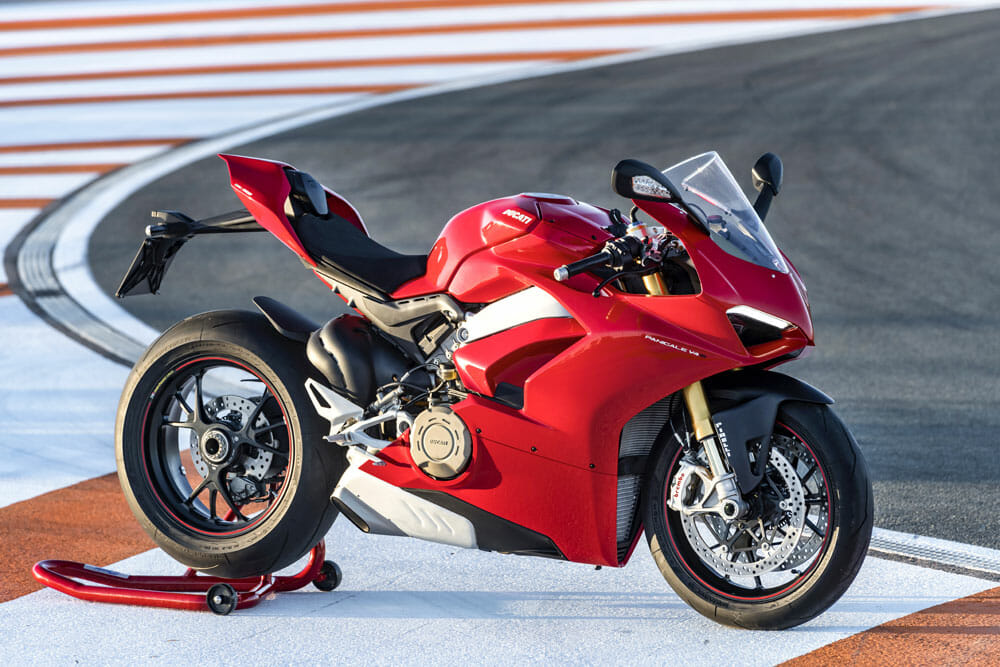
SPECIFICATIONS
|
|
2018 Ducati Panigale V4S ($27,495 – S version tested)
|
|
Engine:
|
Desmosedici Stradale 90° V4, rearward-rotating crankshaft, 4 Desmodromically actuated valves per cylinder, liquid-cooled
|
|
Displacement:
|
1103cc
|
|
Bore x stroke:
|
81 x 53.5mm
|
|
Fuel injection:
|
Electronic fuel injection system, twin injectors per cylinder, full ride-by- wire elliptical throttle bodies, variable length intake system
|
|
Compression ratio:
|
14.0:1
|
|
Power:
|
214 hp @ 13,000 rpm (claimed)
|
|
Torque:
|
91.5 lb-ft @ 10,000 rpm (claimed)
|
|
Exhaust:
|
4-2-1-2
|
|
Transmission:
|
6-speed with Ducati Quick Shift (DQS) up/down EVO
|
|
Clutch:
|
Hydraulically controlled slipper and self-servo wet multi-plate clutch
|
|
Chassis:
|
Aluminum alloy “Front Frame”
|
|
Front suspension:
|
Öhlins NIX30 43mm fully adjustable fork with TiN treatment. Electronic compression and rebound damping adjustment with Öhlins Smart EC
2.0 event-based mode
|
|
Rear suspension:
|
Fully adjustable Öhlins TTX36 unit. Electronic compression and rebound damping adjustment with Öhlins Smart EC 2.0 event-based mode; aluminum single-sided swingarm
|
|
Front brake:
|
Dual 330mm semi-floating discs, radially mounted Brembo Monobloc Stylema (M4.30) 4-piston calipers with Bosch Cornering ABS EVO
|
|
Rear brake:
|
245mm disc, 2-piston caliper with Bosch Cornering ABS EVO
|
|
Front tire:
|
Pirelli Diablo Supercorsa SP 120/70 ZR17
|
|
Rear tire:
|
Pirelli Diablo Supercorsa SP 200/60 ZR17
|
|
Rake:
|
24.5°
|
|
Wheelbase:
|
57.8 in.
|
|
Seat height:
|
32.48 in.
|
|
Fuel capacity:
|
4.23 gal
|
|
Weight:
|
430 lbs. (curb, claimed)
|
